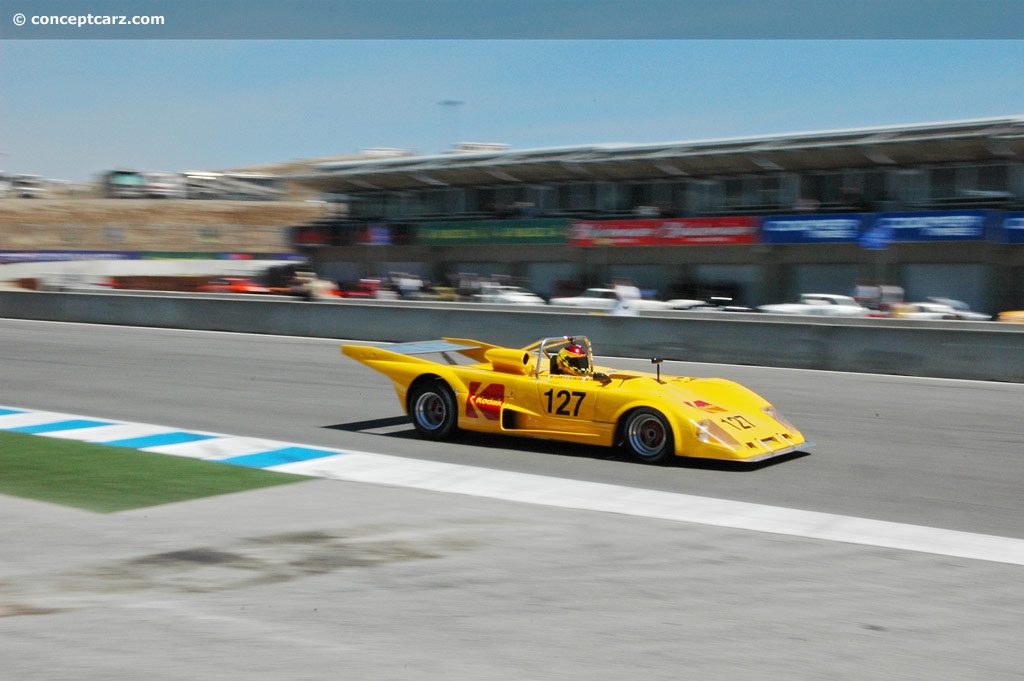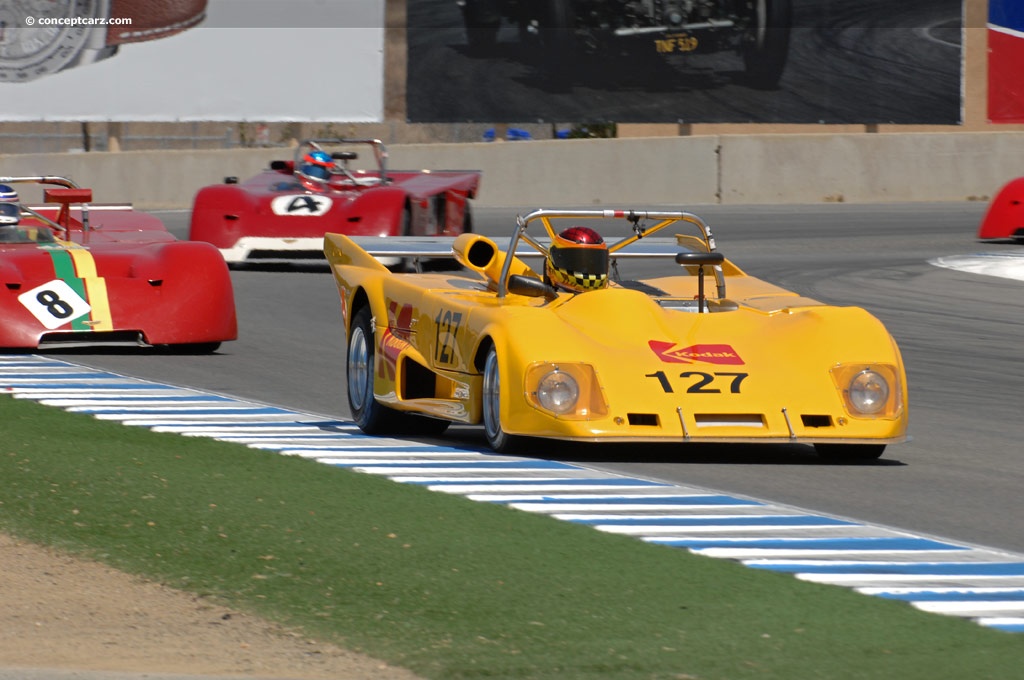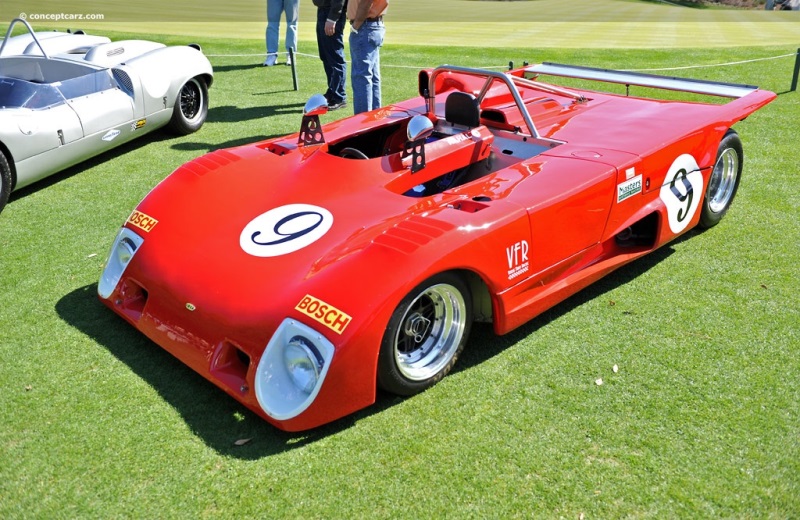1972 Lola T290 Navigation
Lola Cars rose from humble beginnings, from a garage behind the Broadley family's tailoring shop in Bromley, Kent to establishing an enviable reputation in motorsports. From the start, the company focused on build quality and design integrity, as evidenced by the prototype Mark 1 sports car of 1958 which quickly posed a threat to Colin Chapman's dominant Lotus 11s. 
Sports Roadster
Chassis #: HU26
View info and historyThe architect of the early Lola cars wasEric Broadley, joined by his cousin Graham and Rob Rushbrook. The Lola Mk1 was followed by the front-engined single-seater Formula Junio rMk2. Just four years after they had introduced their first racing car, the team introduced a Formula 1 contender. Its design was based on the Formula Junior frame and power was sourced from a 1,500cc Coventry-Climax FWMV V8 engine. Driver John Surtees would enjoy a rather impressive season in the Bowmaker Finance-backed equipe, finishing fourth in the 1962 Driver's World Championship following a victory in the 2000 Guineas race at Mallory Park and a pair of second-place finishes in the British and German Grand Prix. The Lola MK6 GT coupe was another early project, built between 1962 and 1963, and would later serve as the foundation for Ford's GT40. The mid-engined Lola T80 was built around a full-length aluminum monocoque and was piloted by Al Unser and Bud Tingelstad during the 1965 Indianapolis 500. Unser finished seventh and Tingelstad was forced to retire after losing a wheel. This was Lola's first attempt at contesting the Indy 500 and many of the lessons learned were incorporated into the T90 which lined up at the Brickyard in 1966. Three examples of the T90 were built with one being powered by a turbocharged Offenhauser engine and driven by Rodger Ward, while the other two cars used naturally aspirated, twin-cam Ford V8 engines. Piloting these cars were Indy rookies Jackie Stewart and Graham Hill. Stewart's car was forced to retire after it lost oil pressure. At the time, Stewart and Hill's cars were in first and second place. Hill would go on to secure Lola's first Indy 500 victory in only its second attempt. Another important model in Lola's history was the T70, providing both financial stability and racing success for the small British manufacturer. Lola built the chassis and most examples received larger American V8 engines. Over 100 examples were built in the mid-to-late 1960s in open-roofed MK II Spyder, MKIII coupe, and MKIIIB configurations. The T70 Spyder driven by Surtees won the inaugural Can-Am championship. 
Sports Roadster
Chassis #: HU26
View info and historyDuring this time, the company had moved to Slough before relocating to Huntingdon where the present Lola Cars International Company remains. They had built a wide variety of race cars for numerous Formula series, including the high-horsepower T70, but as the 1970s came into view, the company returned to small-bore sports racers. Among their new weapons was the aluminum monocoque T210 wearing open Barchetta bodywork. It was designed to contest the European 2 Litre Sports Car Championship run for Group 6 prototypes. Lola selected the Ford Cosworth FVC with a displacement of nearly 1.8-liters and backed it with a Hewland gearbox. With fiberglass coachwork, the Lola T210 weighed a mere 550 kg. At the helm was Swiss-based Swedish veteran Jo Bonnier, Lola's European agent, who would battle with Brian Redman and his 1,800cc Chevron throughout the season. With both securing numerous victories, the constructor's title was decided in the season finale at Spa-Francorchamps. Redman arrived at the race with a Chevron B16 that had shed several pounds by having its roof cut off. The tactic worked and was able to edge out Bonnier for the win. Bonnier, however, had done enough to win the drivers' title, while Redman's efforts earned his team the constructors' championship. Austrian Helmut Marko won the Championship again in 1971 with the T210's successor, the T212, earning Lola the manufacturer's crown. Going into the 1972 season, new regulations were announced for Group 5 racing, which effectively made the large sports racers obsolete, making Group 6 even more important. Lola began work on a new car that would continue to use an aluminum monocoque chassis (like the T210) and an independent suspension. Bob Marston led the team and was assisted by Patrick Head and John Barnard.The new racer was designed to house two-liter and three-liter engines, the former being known as the T290 and the latter as the T280. The racer was delivered sans engine with that decision left to the privateer. The suspension was comprised of double wishbones at the front while the rear used reversed lower wishbones, trailing arms, and top links. A slippery and aerodynamic body design was formed from fiberglass with downforce created at the rear by a small wing. 
Sports Roadster
Chassis #: HU26
View info and historyThe most popular engine powering the new Lola racer was the 1,790cc Cosworth FVC or the Chevrolet Vega-based four-cylinder unit. The Vega unit was fast but not as reliable as the FVC. Both units were backed by a Hewland five-speed gearbox. When European representative Jo Bonnier was not racing the new T290s, he was selling them to privateers, and no fewer than 34 examples were built. The T290s proved fast and won many races around the world, their Achilles Heel proved to be reliability, resulting in the Abarth-Osella team winning the European Championship. Lola continued to work on the T290, resulting in the T292 for the 1973 season. It had inboard-mounted rear brakes and a larger rear wing, and with the help of the BDG engine, was able to secure the Championship once again for Lola. Continued development resulted in the T294, T296 and T298 versions and the closely related T280 series, powered by 3.0-liter Formula 1 Cosworth DFV V8 engines. In total, there were approximately 100 examples of the T29X-based vehicles built.
by Daniel Vaughan | Oct 2021

Sports Roadster
Chassis #: HU26
View info and history

Sports Roadster
Chassis #: HU26
View info and history

Sports Roadster
Chassis #: HU26
View info and history
by Daniel Vaughan | Oct 2021
Related Reading : Lola 29X History
In 1961 Eric Broadley formed the Lola Racing Car Company. The first cars were front-engined sports cars followed by Formula Junior racers. Soon, Lola was one of the top chassis suppliers in sports car racing. In 1965 the Lola Racing Cars Group introduced the T70. During its lifetime from 1965 through 1969 over 100 examples were produced in three versions. They were designed for endurance racing....
Continue Reading >>
Continue Reading >>
- 1972 Lola T290 Menu
- Article
- Image gallery
- Valuation
- Specifications
- Profiles
1972 Lola T290 Vehicle Profiles
Recent Vehicle Additions
Related Automotive News

John Barnard's Finest: Some of the Greatest of Barnard's Design
The latter-part of Barnards Formula One career would be filled with disappointments and disputes. However, there was no disputing the genius of the man from London. In fact, a couple of innovations that are mainstays in Formula One design were first...

Great British Racing: Get up close to legends of UK Motorsport at London Concours 2024
Four-wheel icons of race and rally from the 1960s to the 1990s will be on display at the capitals top concours delegance.
The Hesketh 308E that epitomised the excesses of Formula 1 in the Seventies, the outrageously over-engined Metro 6R4 rally...

WORLD-FIRST DISPLAY OF ALL SEVEN REMAINING LOTUS 49S LINING-UP AT AUTOSPORT INTERNATIONAL
Autosport International to host display featuring all seven remaining Lotus type 49 cars thanks to their owners from around the world
Celebrations at Autosport International to mark 50 years since this pioneering F1 car first raced
To this day, th...

CHEVROLET TO SHOW CHAPARRAL VISION GRAN TURISMO CONCEPT
Boundary-pushing, Chevy-powered race cars changed motorsports design
DETROIT – When racers Jim Hall and Hap Sharp founded Chaparral Cars in 1962, few could have guessed how they would shake up the conformities of the racing world – and...

John Barnard's Finest: Some of the Greatest of Barnard's Design
The latter-part of Barnards Formula One career would be filled with disappointments and disputes. However, there was no disputing the genius of the man from London. In fact, a couple of innovations that are mainstays in Formula One design were first...

1968 Belgian Grand Prix: A First for McLaren
McLaren and Formula One are truly synonymous. Over the course of its history, McLaren has completed 714 races and have garnered no less than 178 victories. But while McLaren and victory in Formula One are an almost certainty, the very first would be...



























